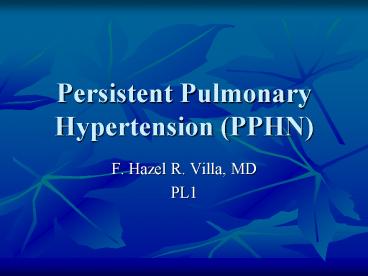Persistent Pulmonary Hypertension (PPHN) - PowerPoint PPT Presentation
1 / 27
Title:
Persistent Pulmonary Hypertension (PPHN)
Description:
Persistent Pulmonary Hypertension (PPHN) F. Hazel R. Villa, MD. PL1. Objectives. to review the fetal,transitional and postnatal circulation in relation to PPHN ... – PowerPoint PPT presentation
Number of Views:2925
Avg rating:3.0/5.0
Title: Persistent Pulmonary Hypertension (PPHN)
1
Persistent Pulmonary Hypertension (PPHN)
- F. Hazel R. Villa, MD
- PL1
2
Objectives
- to review the fetal,transitional and postnatal
circulation in relation to PPHN - To understand the pathophysiology of PPHN as it
applies to clinical manifestations and management
3
Pulmonary vessels
- VASOCONSTRICTORS
- (Maintain high fetal PVR)
- Norepinephrine
- A-adrenergic stimulation
- Hypoxia
- Endothelin
- Thromboxanes
- Leukotrienes
- Platelet activating factor
- PGF2a
- VASODILATORS
- (Decrease PVR during transition)
- PGI2, PGD2, PGE2
- Nitric oxide
- Cyclic GMP
- Cyclic AMP
- Oxygen
- Adenosine
- Bradykinin
4
(No Transcript)
5
Fetal circulation
6
Fetal circulation
- pO2, PGI2, NO
- ADMA -- competes with arginine
- inhibit NOS
- Vasoconstriction
7
Postnatal circulation
8
Transitional circulation
9
Transitional to postnatal
- At birth
- increase in NO, NOS-? cGMP
- increase guanylate cyclase-? cGMP
- increase in PGI2 (effect of estrogen)? cAMP
- DDAH metabolizes ADMA
- Vasodilatation
10
Transitional to postnatal
- At birth
- ventilation
- increase pulmonary blood flow
- Oxygenation
11
Transitional to postnatal
- Oxygen- stimulates NOS, COX1
- Pulmonary blood flow- release of NO, PGI2
- Evidence NO-cGMP pathway is a more potent
modulator of pulmonary vascular tone
12
Increase in SVR
- Removal of the placenta
- Catecholamine associated with birth
- Cold environment
13
Postnatal decrease in PVR
- Expansion of the lung
- Adequate ventilation, oxygenation
- Clearance of fetal lung fluid
14
3 types of abnormalities
- Maladaptation
- Maldevelopment
- Underdevelopment
15
Maladaptation
- Prototype Meconium aspiration pneumonia
- Pneumonia, RDS
- Obstruction of the airways
- Chemical pneumonitis
- Release of endothelin,thromboxane?
vasoconstrictors
16
Maldevelopment
- Prototype Idiopathic PPHN
- (black lung PPHN)
- Vessel wall thickening
- Smooth muscle hyperplasia
- Cause intrauterine exposure to NSAID
- constriction of ductus arteriosus
- genetic
17
Maldevelopment
- Disruption of NO-cGMP pathway
- Disruption of PGI2-cAMP pathway
- Guanylate cyclase is less active
- Increased ROS (reactive oxygen species)?
vasoconstrictor - Increased thromboxane, endothelin
18
Underdevelopment
- Prototype Congenital diaphragmatic hernia
- Pulmonary hypoplasia
- Decreased cross sectional area of pulmonary
vasculature - Decreased pulmonary blood flow
- Abnormal muscular hypertrophy of the pulm
arterioles
19
Clinical signs and symptoms
- PE
- meconium staining
- Prominent precordial impulse
- Narrow split accentuated P2
- Systolic murmur LLSB
20
Labs
- CXR CDH, decreased vascular markings,
parenchymal disease - ECG RV predominance, ST elevation
- ABG hyperoxic test (pO2 lt 100 at 100 O2)
- Pre and postductal ABG (R radial artery
umbilical artery/lower extremity) - 10-15 saturation and or 10-15mmHg pO2
21
Labs
- Echocardiography
- Structural heart disease is determined
- R-L shunting (Ductus or FO)
- Pulmonary arterial pressure is measured
22
Management
- Oxygen 100 pO2 should be kept between
50-90mmHg (O2 saturation gt90) - Correct factors promoting vasoconstriction
hypoglycemia, hypocalcemia, anemia, hypovolemia - Optimize cardiac function (inotropic agents,
volume expansion - Mechanical ventilation
- Surfactant
23
Management
- Inhaled Nitric oxide- an ideal selective
pulmonary vasodilator - OI of gt25
- OI(MAP x FiO2)/pO2 x 100
- Contraindications CHD which are PDA dependent
- (aortic stenosis, interrupted aortic arch,
hypolastic heart syndrome) - May worsen pulmonary edema in obstructed TAPVR
Used to transport patient for ECMO
24
Management
- ECMO
- Goal of this treatment
- maintain adequate tissue oxygenation and
- avoid irreversible lung injury, while PVR
decreases and correcting pulm HTN - ECMO if OI is gt40
25
Other Pulmonary Vasodilators
- Sildenafil- PDE5 inhibitor? increased cGMP
- Milrinone- PDE3 inhibitor? increased cAMP
- Inhaled PGI2
- Superoxide dismutase-superoxide scavenger?
- Dilates pulm vessels, and increase endogenous NO
26
References
- http//neoreviews.aappublications.org/cgi/content/
full/8/1/e14 - http//www.utdol.com/utd/content/topic.do?topicKey
neonatol/1427viewprint - www.emedicine.com/ped/topic2530.htm
- www.emedicine.com/PED/topic2530.htm
- phassociation.org/medical/.../Summer_2006/persiste
nt_ph_newborn.pdf
27
Thank you!































